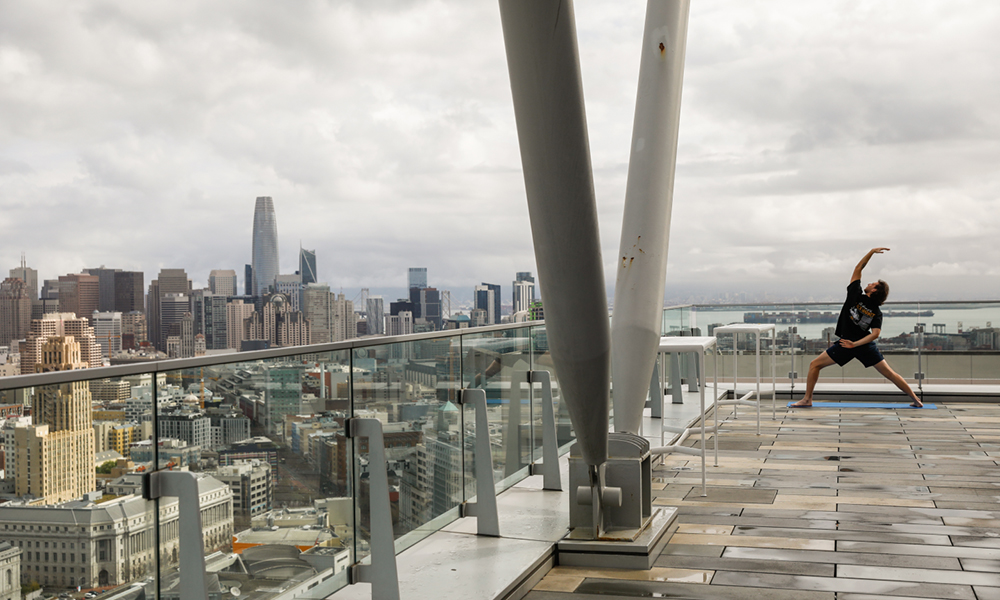
自新冠疫情爆发以来,旧金山市中心就和原来不一样了。在这个全美房价最高的地方,科技企业允许员工无限期远程办公,而他们再也没有回头看。
但他们也没有看得太远,因为最新数据显示,上述变化并没有影响硅谷的增长。
凯南私营企业研究所(Kenan Institute of Private Enterprise)的一份报告显示,旧金山湾区在全美增长最快的都市区榜单中排名第一位。该报告试图在疫情后商业建立新常态之际,绘制出美国增长最快的都市区的总体情况。旧金山都市区在这份榜单上独占鳌头,旧金山市本身却在远程办公时代衰落,原因何在?
湾区委员会经济研究所(Bay Area Council Economic Institute)的数据显示,到2020年年底,湾区大约有45%的工作岗位,即179万个岗位符合远程工作的条件。Kastle Systems公司提供的关于市中心办公建筑使用情况的数据显示,旧金山重返办公室的进度落后于其他大城市。
就在今年10月,旧金山市的市长伦敦·布里德表示,远程工作已经成为许多人生活中的固定元素,随着商业地产价值暴跌,可能会对该市的预算造成“严重打击”。“直到2022年年中,本市的大部分闲置空间都在转租市场上,仍然在为业主带来租金,这一事实表明,写字楼需求下降与房产税收入减少之间存在时差。”旧金山主计长办公室在10月的一份备忘录中写道。
凯南研究所的新研究表明,旧金山市中心必须死亡,才能够实现其周边都会区的繁荣。
领先的城市
凯南的报告称,受到微观经济和商业因素综合作用的影响,一些地方经济的增速快于其他地方,这其实归根到底研究的是美国人对生活工作方式和地点的选择。
该报告衡量了截至2022年8月一年内各地国内生产总值的实时增长。报告分析了就业率、技能和工资水平、行业增长潜力及其他方面的数据,预测了全美几大都市区的经济增长前景,每个都市区的内部构成都具有密切的经济联系。尽管报告没有明确,但远程工作的影响贯穿于结论当中。
排名前五位的都会区中有两个城市来自得克萨斯州,得州在远程工作时代经历了蓬勃发展,前十名中另有两个城市来自北卡罗来纳州。
旧金山湾区凭借2022年4.8%的增长率高居榜首,背后的驱动因素包括科技、创新和初创企业的增长。报告指出,新冠疫情推动企业加速向远程工作模式转变,是Zoom等公司“估值和文化地位提升”的关键。
第二名是奥斯汀地区,这里已经成为了一个科技中心,亚马逊(Amazon)、甲骨文(Oracle)、谷歌(Google)和特斯拉(Tesla)设有大量办公室。奥斯汀今年的GDP增长了4.3%,但报告还指出,随着当地公司招聘放缓,该地区的劳动力增长可能已经见顶。
接下来是西雅图,这里是微软(Microsoft)、亚马逊和波音(Boeing)的总部所在地。在软件和生物技术等产业的推动下,其2022年GDP增长了3.5%。这座城市见证了清洁技术在建筑和制造项目中的应用,吸引了对环境相关工作感兴趣的求职者。
排名第四位的是北卡罗来纳州的罗利-达勒姆地区,由于当地拥有以多所高校为支撑的实力雄厚的生物技术研究基地,常被称为“研究三角”。第五名是达拉斯,它是榜单中唯一一个在新冠疫情高峰期出现人口增长的都会区。丹佛是第六名,它主要受益于人们逃离大都市的回迁风潮。紧随其后的是盐湖城和夏洛特。新奥尔良和奥兰多分别排在第九位、第十位,它们的增长主要与旅游业和酒店业有关。
该研究机构表示,随着美国经济面临持续加息和潜在衰退风险,各地经济将受到不同影响,这主要取决于“经济放缓的性质”。
完整榜单如下:
1. 加州旧金山湾区
2. 得克萨斯州奥斯汀
3. 华盛顿州西雅图
4. 北卡罗来纳州罗利-达勒姆
5. 得克萨斯州达拉斯
6. 科罗拉多州丹佛
7. 犹他州盐湖城
8. 北卡罗来纳州夏洛特
9. 路易斯安那州新奥尔良
10. 佛罗里达州奥兰多(财富中文网)
译者:Agatha
自新冠疫情爆发以来,旧金山市中心就和原来不一样了。在这个全美房价最高的地方,科技企业允许员工无限期远程办公,而他们再也没有回头看。
但他们也没有看得太远,因为最新数据显示,上述变化并没有影响硅谷的增长。
凯南私营企业研究所(Kenan Institute of Private Enterprise)的一份报告显示,旧金山湾区在全美增长最快的都市区榜单中排名第一位。该报告试图在疫情后商业建立新常态之际,绘制出美国增长最快的都市区的总体情况。旧金山都市区在这份榜单上独占鳌头,旧金山市本身却在远程办公时代衰落,原因何在?
湾区委员会经济研究所(Bay Area Council Economic Institute)的数据显示,到2020年年底,湾区大约有45%的工作岗位,即179万个岗位符合远程工作的条件。Kastle Systems公司提供的关于市中心办公建筑使用情况的数据显示,旧金山重返办公室的进度落后于其他大城市。
就在今年10月,旧金山市的市长伦敦·布里德表示,远程工作已经成为许多人生活中的固定元素,随着商业地产价值暴跌,可能会对该市的预算造成“严重打击”。“直到2022年年中,本市的大部分闲置空间都在转租市场上,仍然在为业主带来租金,这一事实表明,写字楼需求下降与房产税收入减少之间存在时差。”旧金山主计长办公室在10月的一份备忘录中写道。
凯南研究所的新研究表明,旧金山市中心必须死亡,才能够实现其周边都会区的繁荣。
领先的城市
凯南的报告称,受到微观经济和商业因素综合作用的影响,一些地方经济的增速快于其他地方,这其实归根到底研究的是美国人对生活工作方式和地点的选择。
该报告衡量了截至2022年8月一年内各地国内生产总值的实时增长。报告分析了就业率、技能和工资水平、行业增长潜力及其他方面的数据,预测了全美几大都市区的经济增长前景,每个都市区的内部构成都具有密切的经济联系。尽管报告没有明确,但远程工作的影响贯穿于结论当中。
排名前五位的都会区中有两个城市来自得克萨斯州,得州在远程工作时代经历了蓬勃发展,前十名中另有两个城市来自北卡罗来纳州。
旧金山湾区凭借2022年4.8%的增长率高居榜首,背后的驱动因素包括科技、创新和初创企业的增长。报告指出,新冠疫情推动企业加速向远程工作模式转变,是Zoom等公司“估值和文化地位提升”的关键。
第二名是奥斯汀地区,这里已经成为了一个科技中心,亚马逊(Amazon)、甲骨文(Oracle)、谷歌(Google)和特斯拉(Tesla)设有大量办公室。奥斯汀今年的GDP增长了4.3%,但报告还指出,随着当地公司招聘放缓,该地区的劳动力增长可能已经见顶。
接下来是西雅图,这里是微软(Microsoft)、亚马逊和波音(Boeing)的总部所在地。在软件和生物技术等产业的推动下,其2022年GDP增长了3.5%。这座城市见证了清洁技术在建筑和制造项目中的应用,吸引了对环境相关工作感兴趣的求职者。
排名第四位的是北卡罗来纳州的罗利-达勒姆地区,由于当地拥有以多所高校为支撑的实力雄厚的生物技术研究基地,常被称为“研究三角”。第五名是达拉斯,它是榜单中唯一一个在新冠疫情高峰期出现人口增长的都会区。丹佛是第六名,它主要受益于人们逃离大都市的回迁风潮。紧随其后的是盐湖城和夏洛特。新奥尔良和奥兰多分别排在第九位、第十位,它们的增长主要与旅游业和酒店业有关。
该研究机构表示,随着美国经济面临持续加息和潜在衰退风险,各地经济将受到不同影响,这主要取决于“经济放缓的性质”。
完整榜单如下:
1. 加州旧金山湾区
2. 得克萨斯州奥斯汀
3. 华盛顿州西雅图
4. 北卡罗来纳州罗利-达勒姆
5. 得克萨斯州达拉斯
6. 科罗拉多州丹佛
7. 犹他州盐湖城
8. 北卡罗来纳州夏洛特
9. 路易斯安那州新奥尔良
10. 佛罗里达州奥兰多(财富中文网)
译者:Agatha
Since the COVID-19 pandemic struck, downtown San Francisco has never been the same again. Tech firms allowed workers in the country’s least affordable housing market to work remotely indefinitely, and they haven’t looked back.
But they haven’t looked far away, either, as new data reveals this shift hasn’t come at the cost of Silicon Valley’s growth.
The San Francisco Bay Area topped the list of fastest-growing cities in the U.S. in a report by the Kenan Institute of Private Enterprise, which seeks to paint a broad picture of the metro areas experiencing the most growth as business establishes a new normal after the pandemic. So how could San Francisco decline during the remote-work area as its metro area topped the fastest-growth list?
By the end of 2020, an estimated 45% jobs, or 1.79 million in total, were eligible for remote work in the Bay Area, according to the Bay Area Council Economic Institute. Since then, data on which downtown facilities were actually being used by workers, provided by Kastle Systems, has consistently shown that San Francisco lags behind other major cities in return-to-work progress.
And just in October, San Francisco Mayor London Breed said that remote work had become a permanent fixture in many people’s lives, and would likely cause a “major hit” to the city’s budget as commercial property values plummet. “The fact that, until mid-2022, most of the city’s vacant space is on the sublease market, and still generating rent for the building owners, is an indication of the lag between a downturn in office demand, and a downturn in property tax,” the San Francisco Controller’s Office wrote in a memorandum in October.
The new study from the Kenan Institute suggests that downtown San Francisco had to die so its surrounding metro area could thrive.
The leader of the pack
Some local economies are growing faster than others due to a mix of microeconomic and business factors, the Kenan report says, as it ultimately points to how and where Americans are choosing to live and work.
The report measured real-time growth in gross domestic product for the year till August 2022. It looked at data from employment rates, skills and wage levels, industry growth potential, and more to forecast the economic growth for the largest economically connected metropolitan areas in the U.S. Although the report didn’t say so explicitly, the impact of remote work was all over the findings.
The top five metro areas on that list boast two cities in Texas, a state that has boomed in the remote work era, and the top 10 include two North Carolina cities.
The San Francisco Bay Area claimed the number one position on the list with 4.8% growth in 2022, driven by technology, innovation, and startup growth. The pandemic-fueled shift to remote work was key to “expanding the valuation and cultural status” of companies like Zoom, the report observed.
The second region on the list is Austin, which has emerged as a tech hub, with a crop of Amazon, Oracle, Google, and Tesla offices in the city. With its GDP growing 4.3% this year, the report notes that the labor gains may have peaked as companies in Austin slow their hiring.
Next comes Seattle, the home of Microsoft, Amazon, and Boeing. Its GDP expanded by 3.5% in 2022, driven by industries like software and biotech. The city has witnessed the adoption of clean technology in construction and manufacturing projects, drawing job seekers interested in environment-related jobs.
In fourth place is the Raleigh/Durham area in North Carolina, commonly referred to as the Research Triangle for its strong university-powered biotech research base. The fifth city on the list is Dallas, which stood out as the only metro area to experience population growth at the height of the COVID-19 pandemic. Denver is up next, as it benefits from individuals moving back to the city to escape from urban areas. That’s followed by Salt Lake City and Charlotte. Growth in New Orleans and Orlando, which occupy ninth and 10th places, respectively, is pegged to tourism and hospitality.
As the U.S. economy braces for persistent interest rate hikes and a potential recession, the effect on local economies could vary depending on the “nature of the slowdown,” according to the institute.
Here is the list in full:
1. San Francisco Bay Area, California
2. Austin, Texas
3. Seattle, Washington
4. Raleigh and Durham, North Carolina
5. Dallas, Texas
6. Denver, Colorado
7. Salt Lake City, Utah
8. Charlotte, North Carolina
9. New Orleans, Louisiana
10. Orlando, Florida






